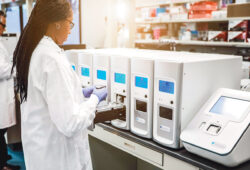Top IP takeaways from the COVID-19 front lines
While infection prevention is one of the utmost goals in a hospital setting, the COVID-19 pandemic has revealed a renewed focus on giving healthcare providers the tools and support they need to stop the spread.

DrPH
“The staff know now we’re coming to help them do better,” says Jennifer Sanguinet, DrPH, Director of Infection Prevention at HCA Healthcare’s Sunrise Hospital in Las Vegas.
Out of struggle come lessons learned. And healthcare systems have learned many when it comes to infection prevention in the pandemic era.
Lesson 1: Communication is key
Sanguinet says communication has played an important role in this effort, particularly given some of the misinformation in the public domain. “We recognized early on that we weren’t going to know everything and that things were changing very rapidly, so communication became the No. 1 priority,” she explains. That often meant daily messages from the hospital’s CEO. “This helped people feel more confident that we were sharing what we knew as soon as we knew it,” she says.

Angie Mitchell, RN, former AVP of Clinical Services at HealthTrust, agrees: “The key to infection prevention has always been education and communication,” she says. “But the pandemic brought it to the forefront, where it’s more appreciated and seen in a new light.”
Lesson 2: Creativity & critical thinking are required
Creativity and flexibility have been critical in managing infection spread during the pandemic, Sanguinet says. Her team recognized that they would need more respirators. As they waited for more to arrive, they worked diligently to keep the almost constantly used machines up and running, and ready to go for the people who needed them.
The team also began using decontamination powered air-purifying respirators (PAPRs), following decontamination guidelines from the Centers for Disease Control and Prevention (CDC). They just had one challenge. They needed a quick way to keep track of the PAPRs’ locations throughout the hospital so they could be available at a moment’s notice. After brainstorming, the team came up with a solution: attaching Tile Trackers to each machine.
“You never know what the talents are on your staff until you put them to the test,” Sanguinet says.

“These infection prevention specialists needed to be fast on their feet,” says Tara Coleman, MBA, BSN, RN, former Infection Prevention Subcommittee Lead and Director of Nursing Services, Clinical Operations at HealthTrust. And they were. “The people who go into this are exceptional critical thinkers, and they were challenged to put those skills into hyperdrive, while at the same time maintaining the confidence and composure to guide the staff.”
Lesson 3: Materials matter
For Coleman, the importance of “fit testing,” which the Occupational Safety and Health Administration (OSHA) requires to ensure that N95 respirators work properly, emerged as a critical lesson.
Clinical staff typically only need to undergo fit testing annually because they use the same type of mask for every circumstance. But with the pandemic, providers used different mask types, and there was a lot of time and effort spent ensuring the masks fit, Coleman explains.
Technology that can bring this process down from 20 minutes to about seven is under review.
Coleman also saw a greater appreciation for the equipment front-line clinicians needed to do their jobs. “Clinicians often took it for granted they would always have the equipment they needed and never worried about keeping up with their mask or counting how many days until it had to be cleaned. It was an eye-opening experience,” she says. “We realized there were a lot of suppliers out there, but many don’t meet the efficacy standards required to protect the clinician.”
Coleman and her team also spent a lot of time educating members about their gear—for example, steps they could take to prevent the skin breakdown that can occur with extended use of N95 respirators.
Lesson 4: Antimicrobial stewardship is as essential as ever
Like everything else during the pandemic, antimicrobial stewardship has become more challenging—in part because of the increased susceptibility of patients with COVID-19 to antibiotic-resistant infection from prolonged hospitalization and the use of immunosuppressing agents such as dexamethasone. But that doesn’t mean antimicrobial stewardship should become secondary.
“There’s a temptation, justifiably so, to focus on emerging COVID treatments at the expense of day-to-day antimicrobial stewardship interventions,” says

Charles Jensen, PharmD, Antimicrobial Stewardship Coordinator at St. Luke’s Health System–Treasure Valley in Boise, Idaho. “Competing priorities make this a constant struggle. But the last thing our patients need is to wrap up their hospital stay with a bout of C-diff [Clostridioides difficile] or a multidrug-resistant infection due to lax stewardship.”

It’s vital to identify the responsible pathogen as quickly as possible so the right antibiotic—or none at all—is used, says Jason Braithwaite, PharmD, HealthTrust’s Senior Director of Clinical Pharmacy Services. “That’s antimicrobial stewardship 101,” he says. “But it sometimes gets lost when a patient is really sick and you’re trying to figure out what to do next.”
One challenge is that the immunosuppressants widely used with critically ill COVID patients alter white blood counts.
“This confounds our ability to track patient improvement,” Braithwaite says. That’s why it’s so important to work closely with the infectious-disease experts. “Using their experience and knowledge is key.”

Rachael Craft, PharmD, Clinical Pharmacist of Infectious Diseases at Mercy Medical Center in Canton, Ohio, works closely with infectious disease physicians to review antimicrobial usage on COVID patients. “I think it is more crucial than ever to have an antimicrobial stewardship team in place at the hospital,” she says. “The physicians do a thorough job evaluating these patients to see if they have any risk factors for a predisposing bacterial infection.” They then rely on lab values to help guide decisions. “I think we have a good handle on this situation because we have the team and proper policies and protocols in place to help us be successful,” she adds.

“During the early stages of the pandemic, clinical uncertainty was high,” says John Hwang, PharmD, Pharmacist at St. Vincent Charity Medical Center in Cleveland, Ohio. “When it came to treating patients with multiple comorbidities, the risk of secondary bacterial infections was a major concern.”
In addition, Hwang notes that early studies suggested that the unnecessary use of antibiotics was high among patients with COVID-19, despite little to no evidence of bacterial infections. “Although there has been an increasing amount of research involving the use of antimicrobials on COVID-19 patients, the results have been inconclusive,” he explains. “As a stewardship pharmacist, it’s my duty to keep up with the new literature and recommendations from the CDC and NIH [National Institutes of Health] to ensure antibiotics are used judiciously.”
Looking ahead, these lessons learned are integral in facing the pandemic as it continues in real-time and pivoting when required. “Everyone is stretched thin deciphering the latest pre-prints, addressing shortages and navigating emergency usage authorization nuances affecting COVID treatments,” says Jensen. “We’ll all need to find innovative solutions to make sure basic stewardship interventions like de-escalations are still happening consistently.”
“Many of the efforts initiated as a response to COVID will remain a part of infection control protocols and processes to avoid disruptions,” predicts Mitchell. “We used to talk about ‘what ifs’ like a pandemic in the future, but the future is now.”
Share Email Antimicrobial Stewardship, COVID-19, Infection Prevention, Q1 2021






